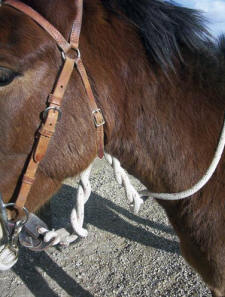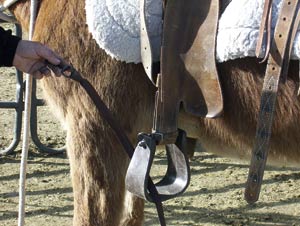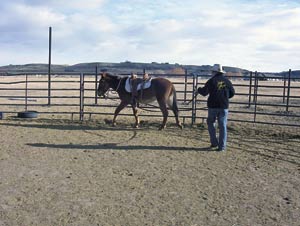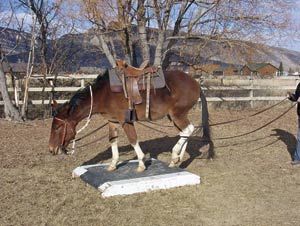I am often asked, “Should I ground drive my mule?” The answer I
give is “maybe.” In order to properly train a mule, you must
look at each mule individually. Some characteristics in a mule
may warrant ground driving while others may not.
Any good training lesson is good to teach a mule, but may not be
necessary because all mules are different. A mule that has a lot
of energy or a mule that does not like to move out must be
trained differently.
If I have a mule that needs bridle work and does not like things
behind him, he is a good candidate for ground driving. Another
good candidate is a mule that is a little spooky to new
surroundings. Ground driving allows me to walk a safe distance
behind the mule and ask the mule to respond to my rein cues. In
some respects it simulates me being on the mules back because I
am behind him and out of sight to a degree, giving him cues to
get a response.
 |
| Twist the reins and
use the throat latch to secure them in a safe manner
|
| |
 |
| Take the loose end
of your lariat through the stirrup |
I ground drive many of the young mules I train because it
adds another layer of training to the bridle work; it gives them
a better understanding of cues I will give once I am in the
saddle.
Before you begin ground driving your mule, you will need to
teach the mule to accept ropes around his legs, feet and hind
quarters. If you are unsure how to do this, give me a call and I
will be happy to help you. This will also be covered in a future
article.
You will also need to have a saddle and a snaffle bit on your
mule. Twist the reins of the bridle under the mule’s throat and
run the throat latch of the bridle through the twist and buckle
to the bridle. I start ground driving a new mule in a round pen
using two 30-foot lariats as driving reins.
With your mule in a round pen or other safe area, take the loop
end of one lariat and run the end through the left ring of the
snaffle bit, then close the loop with the loose end of your
lariat by pulling it through the loop. Then after your lariat is
closed, take your loose end through the left stirrup. Repeat
this on the right side so you have two 30-foot reins.
It is important to remember when you ground drive, handle the
reins the same as when you ride. If you want the mule to respond
to the bridle with little pressure, you must ask with little
pressure. It is impossible for a mule to respond lightly if we
grab the rein and jerk.
To get started, kiss or cluck to the mule and ask the mule to
walk forward. If the mule does not like things behind him, he
will walk keeping you to one side or the other until he is
comfortable with you behind him. Remember to stay far enough
back that the mule can not kick you.
When ground driving the mule, ask for changes of direction often
with the reins, this will get the mule to forget about things
behind him and concentrate on your cues. If he is asked to
respond to a cue, he will not have time to think of anything
else.
 |
| Begin ground
driving in a safe place such as a round pen. Use this
space to teach your mule. If your mule
spooks, disengage his hind quarters with the reins and
take his nose towards the fence |
If at any time you feel unsafe or the mule is out of control,
put pressure on one rein and disengage the mule’s hind quarters,
just as we did earlier with bridle work. Work on getting the
mule to respond to light pressure on the reins. When the mule
accepts me behind him I will switch to a 40-foot lounge line
with a snap at each end.
This is the same as the single rope rein I ride with. This
allows me to slide the rein through my hands like when I am
riding. It is very important when using your reins not to have
pressure on the off-side rein. I slide the rein through my hands
so the off-side has the entire extra rein and there is no
pressure applied.
Once the mule is responding to my light cues, I will ground
drive the mule over tarps, around tires, etc. This will raise
the level of excitement of the mule. Once your mule raises his
excitement and responds to your light cue, he is telling you
that he is learning the cue.
Now you can think of things to ground drive your mule around,
over and through. Make sure every item is safe. Your mule needs
to have a safe experience in order to build trust in you.
 |
| Use ground driving
to teach your mule to listen to cues, even while walking
over obstacles. |
I have many items I use in my trail clinics that work great for
ground driving. I will ground drive the mule over a bridge,
around a mail box, through a small jump, through a rope gate and
under a noodle wall, through a small water-obstacle and so on.
The more things you can use the better the mule will respond to
you rein cues.
By ground driving your mule, you have not only taught him to
accept things behind him, you have improved his response to your
rein cues.
Tim accepts outside mules in training and offers private weekly
or daily lessons for mules and their owners at your ranch/farm
or his. To book a lesson, training or to host a clinic at your
facility, contact Tim.
Tim can be reached at
www.diamondcreekmules.com, or by phone at 307/899-1089, or
email:
bliss@wavecom.net.
|